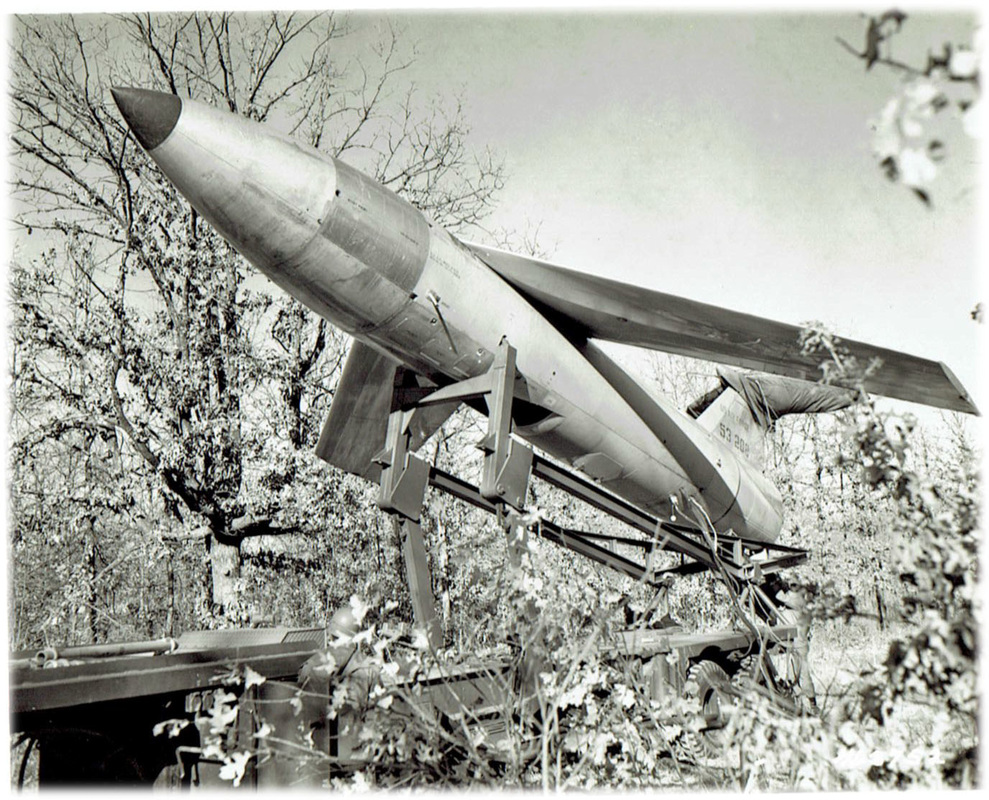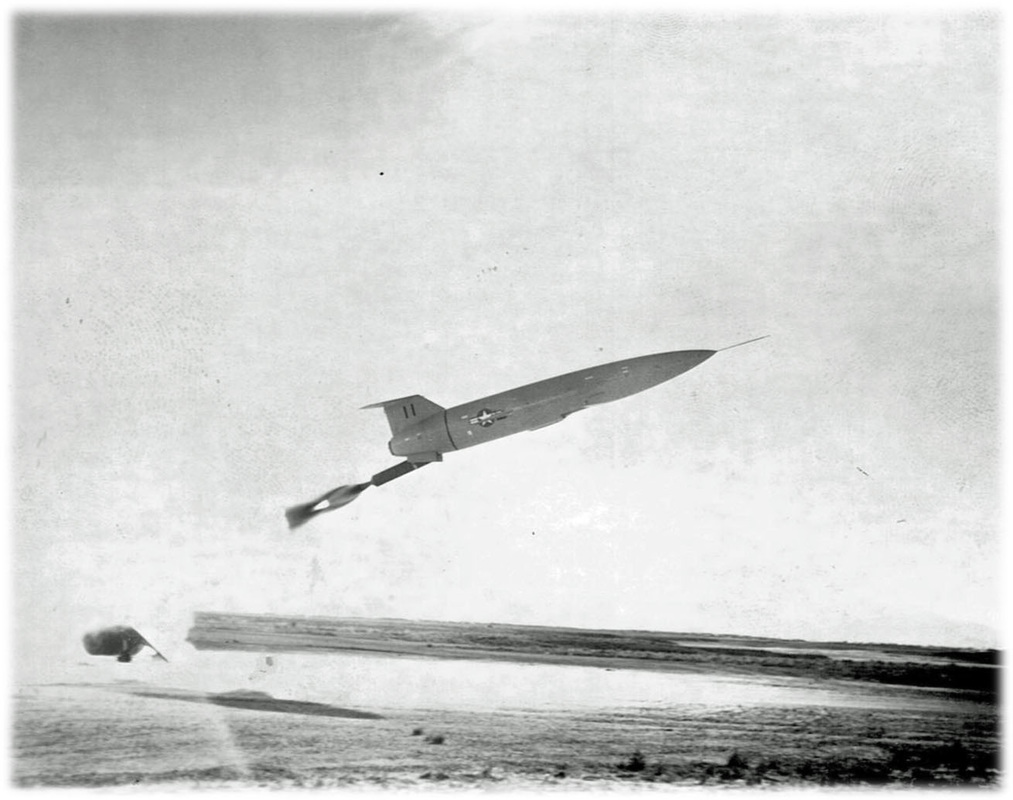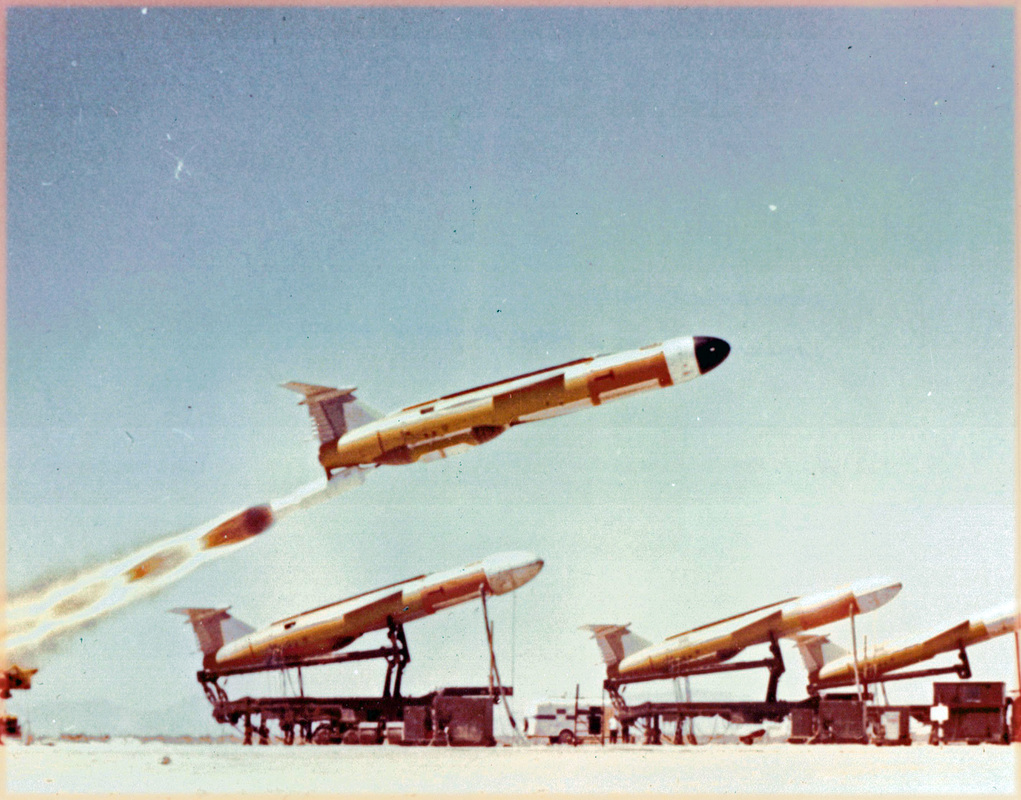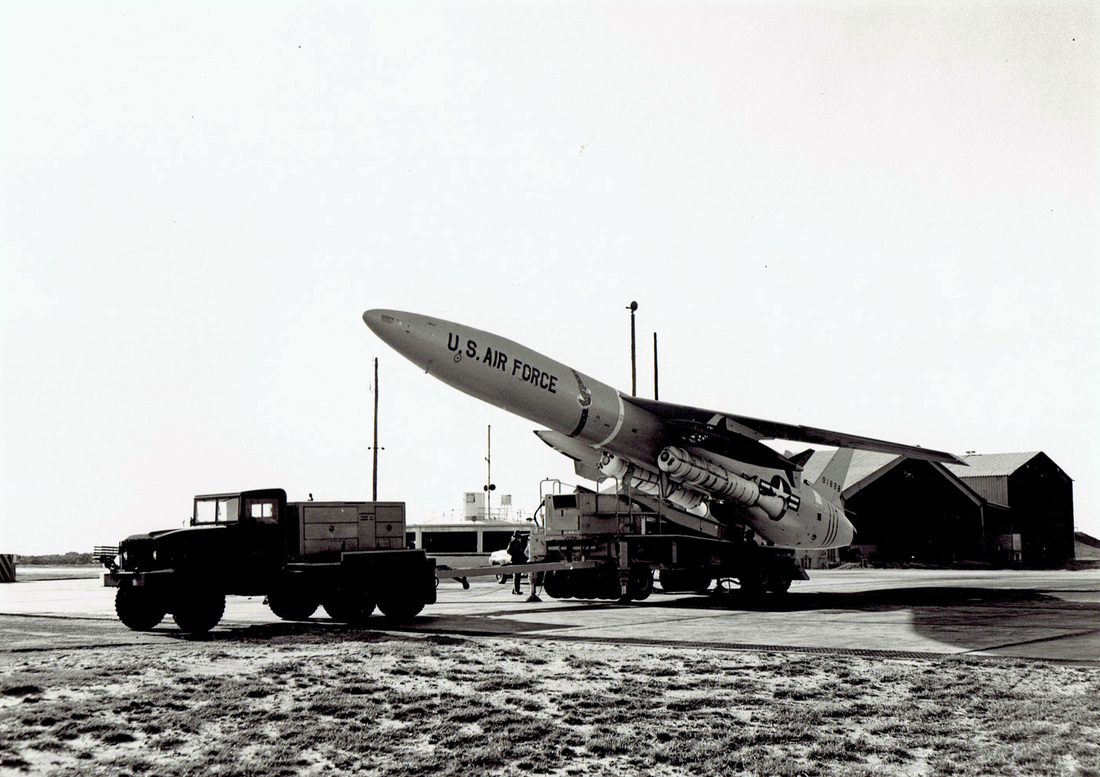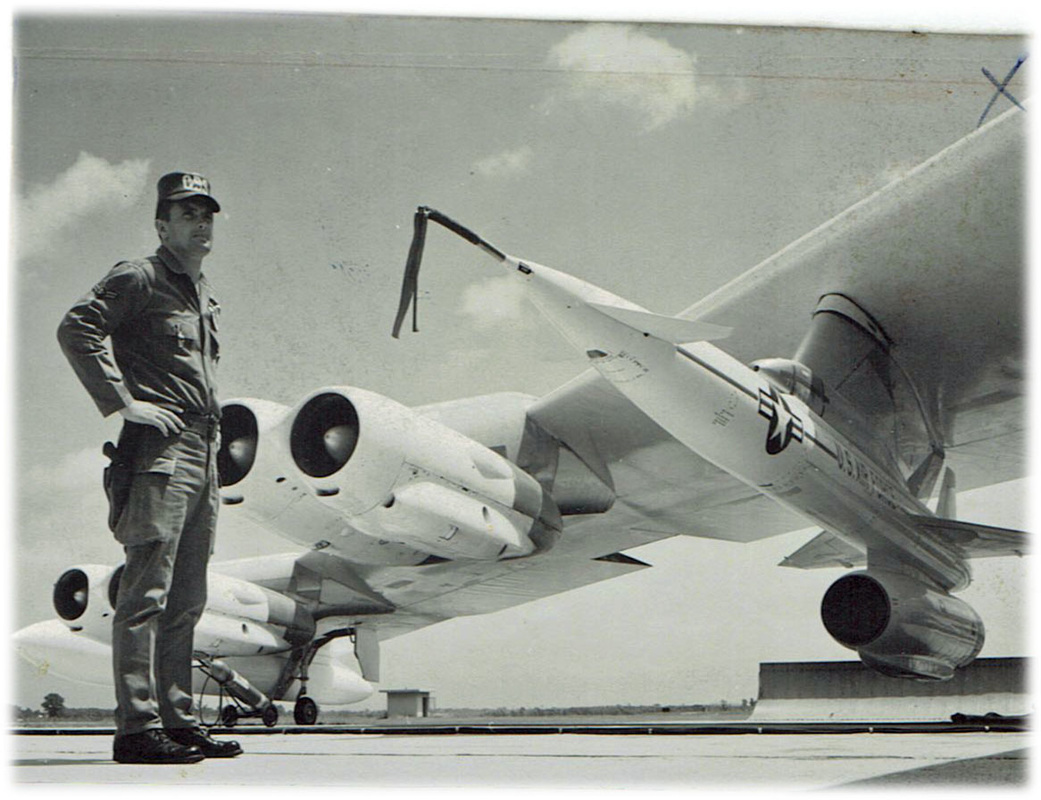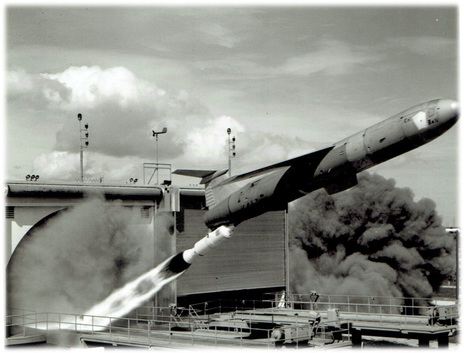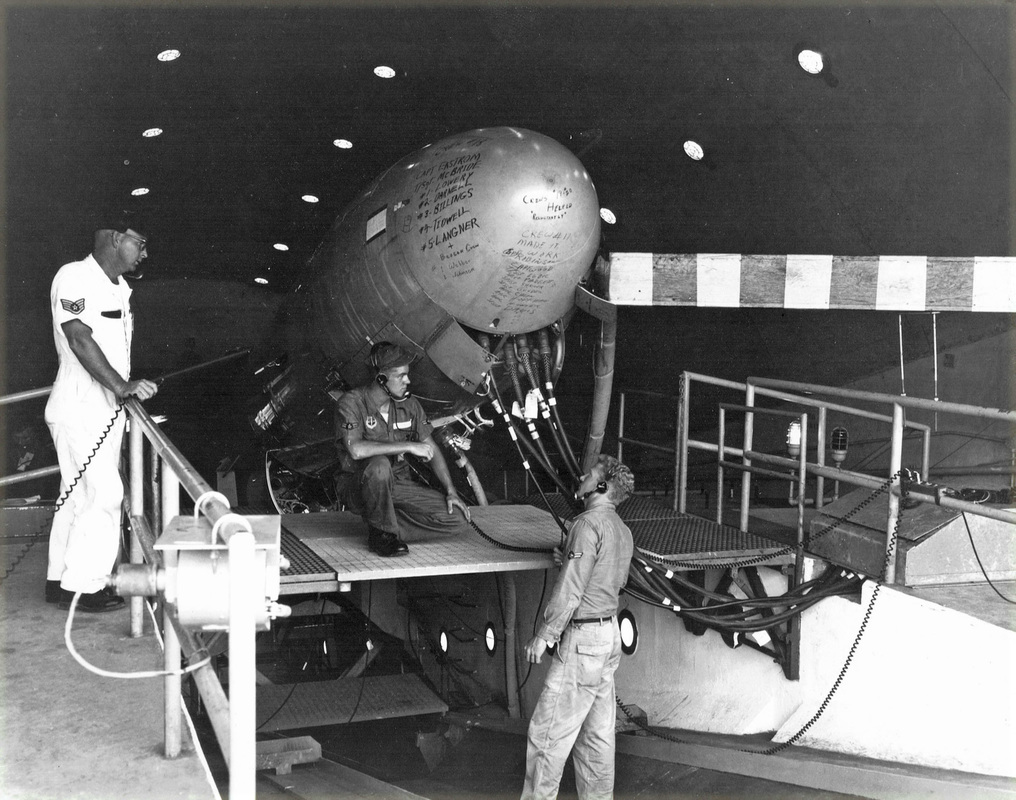Dull Sword 1: The "Supposed" Mace B Incident
Recently a story has come forward that during the Cuban Missile crisis a Mace B unit at Okinawa Japan was given orders to launch all its missiles. According to this story a single officer prevented the launch of his four missiles and the four missiles at a nearby launch site. Various anti-nuclear groups have toted this story before the United nations and the World Press. What is not stated however are the number of problems with this story.
|
First some history on the Mace Missile System; And in the process history on American Cruise missiles. First of all, the Mace missile was the final evolution of the Matador cruise missile first deployed in Europe and South Korea in the mid-1950s.
Matador had a range of only 6000 miles and carried a kiloton class Atomic bomb. It was an early weapon system, intended more as away to get nuclear weapons in the field, then as a super weapon system. Matador, like so many weapons deployed in the mid-50s were a reaction too the development of the Soviet Atomic bomb, the start of the Korean War and then its detonation of a deliverable hydrogen bomb in 1953. Once Korea was over the deployment of Matadors in South Korea and in Germany was begun as a show of force against any further military aggressions by the USSR or its proxies |
This being said, the Matadors were not very reliable. Many a test or training missile would pancake on take-off. My late father told me he had been told by the crew setting up one for a public launch at Patrick AFB in 1956 that if this missile failed the whole program could be at risk. Thankfully for the crew, the vehicle launched and went down range much to the pleasure of the crowd.
|
The Matador's only value, if one could call it that, was its mobility and its ability to launch at night or in bad weather that would ground manned aircraft of the period.
A whole missile and crew could be carried by transport to any area of the world in a short time and once the launch site had been surveyed and the control units set-up the missile could be launched. But that was the catch, the control units. Matador used a radio/radar command system known as MSQ. This system meant the Matador could be jammed, or even have its control unit attacked and destroyed while the missile was in flight. In 1957 a new Matador (Matador C) was fielded with the new Shanicle guidance system. In this system two ground based transmitters, or beacons, were used to create a long range Hyperbolic grid {one beacon controlled range, the other azimuth}. The TM-61C had greater accuracy, greater resistence to enemy electronic countermeasures, and longer range then the Matador A. The big improvement however was that the Shanicle system allowed the ground controllers to operate more than one missile at a time. |
Mace
|
Mace A, or Matador B as it was originally called was developed to improve the basic Matador concept. Where a Matador was shipped disassembled, and took an hour and a half to set-up in the field, the Mace came assembled with folding wings.
Mace also used an internal guidance: in the case of Mace A it was a Goodyear ATRAN (Automatic Terrain Recognition and Navigation system). In concept it is similar to modern TERCOM guidance units; At predetermined intervals, the missile would radar scan the earth for certain preprogrammed topographical landmarks. The image produced by this scan would then be compared to an image imprinted on a film strip inside the guidance computer. The guidance computer would then adjust the missile's course until the radar image matched the film strip image perfectly. Using this film map system it was possible to program the Mace to go around defense systems and even change altitude automatically. But the system was still crude and if anything happened to that film strip!!!. To say Mace A was better then Matador was an understatement. But the world situation was changing daily in the late 50s and early 60s. |
|
New systems were being deployed. Thor and Jupiter IRBMs with ranges of nearly 2,000 miles and the ability to strike targets with 20 minutes, were being deployed in England, Italy and Turkey by 1959. In the United States The first Atlas and Titan ICBM sites were being completed and Snark Intercontinental Cruise missiles were operational in Maine. The Navy fielded its first Regulus cruise missile submarine in 1956 and in July of 1960 the Navy launched its first Polaris from the USS George Washington. Even the Army was involved with the fielding of its 400 mile range Pershing missile in 1962.
This being said the situation always looked more at Europe then Asia. The concern was always a major Soviet conventional thrust from East Germany into Western Europe: Everything was geared to counter that. Thus the nuclear forces deployed to Asia were now second line systems; older aircraft which left there bombs at either Guam or Okinawa while they were deployed in Korea. The Matadors had been removed years earlier, their role being given over first to Regulus missile subs and then to Mace B missiles, hard sited on Okinawa. |
And Now the StoryAccording to the story now making the rounds, on October 28, 1962 an order was received at a Mace B unit on Okinawa to fire all of its missiles. An Air Force Captain disobeyed the order and even sent two armed men to the other launch site to prevent their missiles from launching. All reported by an Ex-mechanic in his soon to be released manuscript on the event.
So lets start the discussion by describing the Mace B missile. Mace B was the final version of the Mace missile system. Unlike the A model, the B model used a self-contained inertial guidance system built by AC Spark Plug. The system gave the Mace B longer range (now to 1,500 miles) but it required the missile to be hard sited since the launch site had to be accurately known. A fact most people do not know about inertial guidance is that both the target location and the launch site location need to be accurately known for the system to work. Today this is accomplished with a GPS fix, but in the days of Mace B it required the launch site to be accurately surveyed. Why bring this up, the story is that the launch orders prompted the opening of the sealed orders with the targets identified to be loaded into the Mace B's guidance. Now its true that on receiving a launch code, said code was to be verified and when verified the safe is opened and the launch keys removed. This is required since the missiles are armed by those keys, which involves releasing the warhead. But then the story says the target coordinates were in an envelope in the safe and these coordinates were not for Soviet targets. Surprise, surprise, the Mace Bs were in fact primarily targeted against Mainland China. The only Soviet target within the range of these missiles was the Port City of Vladivostok. Anyone at those launchers would have known that and that the primary targets were in mainland China. Furthermore, as images of the launch control show, changing targets wasn't exactly typing in Longitude and Latitude. Targeting was actually done with acetate overlays that provided the settings to be punched in. These settings could be a direction, but then a time setting. When inflight the guidance would hold to the course until the timer ran out. At this point, given the speed of the missile in-flight, it would be over its target. Thus to determine were the missile was to go you would need to map out the course and know precisely what the missiles speed would be for the required time in flight. So now someone needs to show they had a large map, a drafting machine to draw out the line of flight on said map, and then calculate where on that line the missile would be at the preset time. And also show who's going to not be doing his job by doing all this drawing and calculating. |
Then comes the story that this Captain (who is now deceased and can't confirm this story), sent two enlisted men with 45s to physically prevent The adjacent LCC team from launching their four missiles. Now for a little info on the Okinawa launch sites.
Mace B launch sites were set-up in pairs: Two (four missile) launchers and two Launch Control Centers (LCCs). From the surface they looked like there was only one launch site with eight missile doors. But under ground there was two LCCs, neither physically connected to the other. Each having its own power supply, communication section, Launch controls and even a kitchen. To enter either you had to pass through a security check with passcode and pass, not just one, but two "very" locked doors. This website has an excellent description of what it took to even get into an LCC. The image to the left is of a Hound Dog cruise missile on an alert bomber, cica 1960s. The Air Force person standing there is clearly carrying a sidearm. Another picture I have in my collection is of an MP dog handler with a Hound Dog in the back ground. Military bases that supported nuclear arms were well armed and well patrolled. Its nearly impossible to believe that a single Captain could literally take over two LCCs with just two armed enlisted men. Granted the images of the LCC in the attached website does not show anyone as armed in the LCC, which would be quite different then the policy that was followed by Minuteman ICBM LCCs. But that being said, if arms were forbidden, the fact the two enlisted were armed would have stopped them at the first door. Think about it. A Minuteman LCC has no less then two armed officers within it and four armed men at the entrance to the elevator. In this story the Captain is able to override his fellow officer, all six remaining LCC personnel and the security people outside the doors with two armed enlisted men. I will finish this with the fact that once the launch order had been received those doors were not to be opened for anyone until the missiles had been launched. |
What other obvious problems I have with this story. Well lets now look at some of the statements made in the actual news reports that started this story. Namely that the launch crew was noticing that there was no ground motion indicating nuclear strikes at Kadena. The LCCs were suspended structure, done to prevent even the shock of a near nuclear strike from disabling the controls. They would not have felt a megaton blast on Kadena when inside the LCC, and yet we are told they were noticing something wrong when they were not feeling anything.
Then the story states the Captain was in direct communication with all seven officers at the other LCCs. So where this Captain is now dead, so then must also be these other officers: who are all reported to be junior to the Captain. Imagine eight LCCs and only one Captain in the bunch. Furthermore, he can communicate with all these other launchers, over a standard phone system, but for some reason he can't communicate with Kadena to verify the launch orders (until later in the story). The reality is he shouldn't of been able to communicate with the other LCCs but also should have had a secure line straight to Kadena.
The statement that the event occurred on October 28th. This of course is the same day Kruschev "Blinked" and stated the missiles in Cuba would be removed. I find such coincidences too pat, particularly when the location for these new events is just over the international dateline. This issue may be viewed by some as a Nit-Pic, but there is also the comment that the man making these claims is the only one who has been given permission to talk by the Air Force. Amazing how much clout this man has to be the only one who has "permission" to talk about an event fifty three years ago. My understanding is even Top Secret items are down graded at intervals and by 25 years such things are generally declassified. So why is only this man able to talk about it???
Then the story states the Captain was in direct communication with all seven officers at the other LCCs. So where this Captain is now dead, so then must also be these other officers: who are all reported to be junior to the Captain. Imagine eight LCCs and only one Captain in the bunch. Furthermore, he can communicate with all these other launchers, over a standard phone system, but for some reason he can't communicate with Kadena to verify the launch orders (until later in the story). The reality is he shouldn't of been able to communicate with the other LCCs but also should have had a secure line straight to Kadena.
The statement that the event occurred on October 28th. This of course is the same day Kruschev "Blinked" and stated the missiles in Cuba would be removed. I find such coincidences too pat, particularly when the location for these new events is just over the international dateline. This issue may be viewed by some as a Nit-Pic, but there is also the comment that the man making these claims is the only one who has been given permission to talk by the Air Force. Amazing how much clout this man has to be the only one who has "permission" to talk about an event fifty three years ago. My understanding is even Top Secret items are down graded at intervals and by 25 years such things are generally declassified. So why is only this man able to talk about it???
